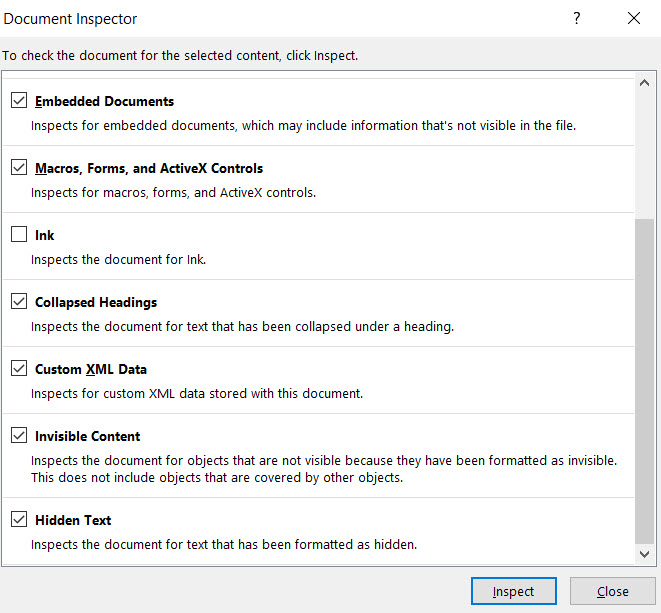To determine which Word 2016 style is currently in use, refer to the Style Gallery. The style of any selected text, or text where the insertion pointer blinks, appears highlighted. The current style is also highlighted if the Styles pane is visible. To specifically examine the style for any text, use the Style Inspector. Check in a file to a document library Open the library, and select the file you want to check in. Click the ellipsis (.) in the toolbar and then click Check In. Note: You can also right click the file, click Advanced or More, and then click Check In. In the Check In dialog box, you can enter a comment, such as what you changed or added. To find the Document Inspector, click on the File tab, then open the dropdown menu under the Check for Issues in the Prepare for Sharing box. Select the first option: Inspect Document. Check each element of your document you would like inspected, then click Inspect at the bottom of the box. The Document Inspector will run. To use Document Inspector: Click the File tab to go to Backstage view. From the Info pane, click Check for Issues, then select Inspect Document from the drop-down menu. Document Inspector.

Overview

You may not be aware that your Word, Excel, and PowerPoint files often contain hidden or personal information, such as revisions or comments, that others can access. Depending on the nature of the information, this could place you in an embarrassing or compromising position. It could even potentially put the university at legal risk.
For example, during the discovery phase in a lawsuit, electronic copies of relevant documents could be subpoenaed. Any hidden comments or revisions in these documents could then possibly be used as evidence.
Inspect Document In Word 2016

Inspect Document In Word 2013
Examples of hidden or personal information that are stored in Office documents include:

- Tracked changes, comments, annotations, and versions, even if not displayed
- Hidden text or data cells
- Presentation notes
- Previously deleted text
- Name of author and person who last modified the file
To protect any sensitive information from accidentally being made public, Information Technology Services recommends that you get into the habit of removing this information before distributing final electronic copies of your documents. There are some simple ways to do this, as described below.